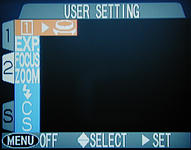
|
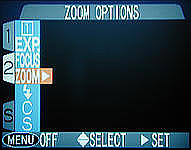
|
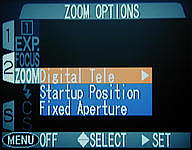
|
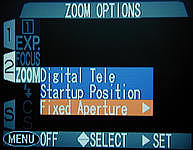
|
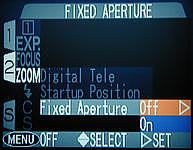
|
Note that once this option is chosen, it will stay there even after turning off the camera. Therefore, you need to go through the above procedure again to reverse the setting..
Many years ago, zoom lenses have constant maximum aperture. For example, 80-200mm F4.0 means the maximum aperture throughout the whole zoom range from 80mm to 200mm is the same F4.0. Nowadays, it is different. In fact, only professional zoom lenses are of this type. Most consumer type zoom lenses have a variable maximum aperture. For example, the on-camera lens of the 990 is 8-24mm F2.5-4.0, which means in the widest zoom setting (i.e., 8mm) the maximum aperture is F2.5 while in the longest setting (i.e., 24mm) the maximum aperture is F4.0. This is a more than one stop difference. Is this unusual? Not at all. Especially when Leica and Zeiss started to manufacture variable aperture zoom lens, it is going to be the trend.
So, what is wrong with this variable aperture design? Actually, nothing is wrong. When you zoom out (resp., in), you have a smaller (resp., larger) aperture and consequently the fastest available shutter speed becomes slower (resp., faster). In general, it is within one stop. However, this variable aperture does cause some problem when the aperture has to be controlled precisely. One of these situations is when using flash lights. Since the guide number of a flash is equal to the product of flash-subject distance and aperture, if aperture changes when zooming, the flash-subject distance should also be changed. For example, suppose we use a flash of GN 100. Suppose initially we choose to use aperture F5.6 and place the flash 100/5.6=18 ft from the subjects. Then, to get a tighter shoot we zoom in which causes the aperture to change to F8.0. If we ignore this aperture and take a shot, it is likely that the result will be an under-exposed one. To maintain correct exposure, we need to reposition the flash at a distance of 100/8 = 12.5 ft.
To partially overcome the problems caused by the variable aperture feature, Coolpix 990 can maintain aperture within 1/3 stop in effect before zoom operation started, if possible. More precisely, the camera will do its best to keep the selected aperture with 1/3 stop as you zoom. However, if the camera can maintain this 1/3 stop error range, aperture changes. Consequently, constant aperture while zooming may or may not be maintained. Note that this fixed aperture is only available in the Aperture-Priority mode and Manual Exposure mode when you can set aperture manually.
To activate or deactivate this fixed aperture feature, please follow the procedure below:

|

|

|

|

|
Note that once this option is chosen, it will stay there even after turning off the camera. Therefore, you need to go through the above procedure again to reverse the setting..